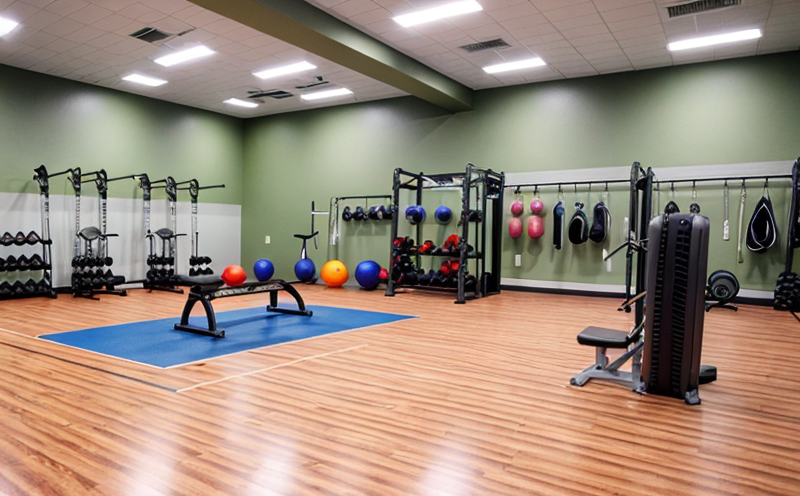Belt Endurance Testing in Treadmills
The endurance of a belt on a treadmill is critical to its performance and safety. The belt must withstand continuous use without wear, tear, or failure that could compromise the user's safety or affect the accuracy of any biomechanical data collected during exercise. This testing ensures compliance with international standards such as ISO 20678 and ASTM F1892.
The test involves simulating the conditions under which a treadmill belt would be used, typically by running it continuously for an extended period at various speeds and inclines. The testing apparatus consists of a treadmill with a calibrated belt that can be monitored for wear indicators such as thickness changes or structural integrity.
Preparation for the test includes ensuring the treadmill is set up according to manufacturer specifications and is operating within its defined performance range. The belt should be free from any foreign objects or debris that could affect testing accuracy. Once prepared, the treadmill is run continuously at progressively increasing speeds and inclines until signs of wear are observed or a predetermined duration is reached.
The results of this test provide critical insights into the durability and reliability of the belt material used in treadmills. These tests help manufacturers identify potential weak spots in their design early on, ensuring that any necessary improvements can be made before products reach the market. This process also helps ensure compliance with relevant safety regulations.
Understanding the importance of this test is crucial for quality managers and R&D engineers looking to enhance product longevity and performance. By conducting regular belt endurance tests, these professionals can monitor trends in material degradation and make informed decisions about design modifications or component replacements.
Why It Matters
Belt endurance testing is essential for maintaining the integrity of treadmill belts over time. Improperly designed or manufactured belts can lead to dangerous situations such as slipping, tripping hazards, or even catastrophic failure during use. Such failures not only pose risks to users but also reflect poorly on brand reputation and potentially result in product recalls.
Compliance with relevant standards is vital for manufacturers, ensuring that their products meet safety requirements set by regulatory bodies worldwide. Failure to adhere to these standards can lead to legal consequences and damage consumer trust.
- Enhanced Safety: Ensures users are not at risk of injury due to belt failure.
- Better Brand Reputation: Demonstrates commitment to quality and user safety.
In addition, consistent testing helps improve the overall reliability and longevity of treadmills, leading to customer satisfaction and increased product life cycle. This translates into lower maintenance costs for consumers and higher profitability for manufacturers.
Scope and Methodology
The scope of belt endurance testing in treadmills includes assessing the durability of the belt under simulated use conditions that mimic real-world scenarios. The methodology involves several key steps:
- Belt Setup: Calibration and preparation of the treadmill belt for testing.
- Testing Conditions: Running the treadmill at various speeds and inclines to simulate typical usage patterns.
- Data Collection: Monitoring parameters such as thickness, material integrity, and wear indicators during the test.
- Analysis: Evaluating collected data against predefined criteria to determine pass/fail results.
The testing apparatus typically includes a treadmill equipped with sensors capable of measuring belt performance metrics. These metrics are analyzed using statistical methods to ensure reliable results.
| Parameter | Description | Acceptance Criteria |
|---|---|---|
| Belt Thickness | Measurements taken at multiple points on the belt. | No significant reduction in thickness after testing. |
| Surface Integrity | Evaluation of surface texture and uniformity. | Maintains consistent friction coefficient throughout the test. |
| Wear Indicators | Visual inspection for signs of wear or damage. | No visible defects that could compromise safety. |
This structured approach ensures accurate and reproducible results, providing valuable information to manufacturers during product development and quality assurance processes.
Use Cases and Application Examples
- Sporting Goods Manufacturers: Testing belts used in treadmills for home gyms to ensure long-term durability.
- Fitness Centers: Assessing the reliability of treadmill belts before purchasing new equipment.
- R&D Engineers: Iteratively improving belt design and materials based on test results.
In one example, a major fitness equipment manufacturer conducted extensive belt endurance tests using a calibrated treadmill. Over several days, they ran the machine continuously at varying speeds and inclines to simulate user activities. After thorough analysis of the collected data, they identified areas where improvements were needed in the belt material to enhance its longevity.
Another case involved a fitness center that was experiencing frequent complaints about treadmill belts wearing out too quickly. By having an independent laboratory perform detailed endurance tests, they discovered that certain models had been improperly manufactured and promptly initiated recalls and replacements.





